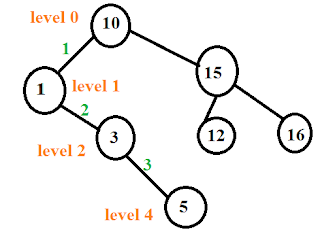21. Consider an array representation of an n element binary heap where the elements are stored
from index 1 to index n of the array. For the element stored at index i of the array (i<=n),
the index of the parent is :
(1) floor ((i+1)/2)from index 1 to index n of the array. For the element stored at index i of the array (i<=n),
the index of the parent is :
(2) ceiling ((i+1)/2)
(3) floor (i/2)
(4) ceiling (i/2)
22. The following numbers are inserted into an empty binary search tree in the given order :
10, 1, 3, 5, 15, 12, 16. What is the height of the binary search tree ?
(1) 310, 1, 3, 5, 15, 12, 16. What is the height of the binary search tree ?
(2) 4
(3) 5
(4) 6
23. Let G be an undirected connected graph with distinct edge weight. Let Emax be the edge
with maximum weight and Emin the edge with minimum weight. Which of the following
statements is false ?
(1) Every minimum spanning tree of G must contain Emin.with maximum weight and Emin the edge with minimum weight. Which of the following
statements is false ?
(2) If Emax is in minimum spanning tree, then its removal must disconnect G.
(3) No minimum spanning tree contains Emax.
(4) G has a unique minimum spanning tree.
Correct Answer is: (3) No minimum spanning tree contains Emax.
24. A list of n strings, each of length n, is sorted into lexicographic order using merge - sort
algorithm. The worst case running time of this computation is :
(1) O(n log n)algorithm. The worst case running time of this computation is :
(2) O(n2 log n)
(3) O(n2 + log n)
(4) O(n3)
Correct Answer is: (2) O(n2 log n)
25. Postorder traversal of a given binary search tree T produces following sequence of keys :
3, 5, 7, 9, 4, 17, 16, 20, 18, 15, 14
Which one of the following sequences of keys can be the result of an in-order traversal of
the tree T ?
(1) 3, 4, 5, 7, 9, 14, 20, 18, 17, 16, 153, 5, 7, 9, 4, 17, 16, 20, 18, 15, 14
Which one of the following sequences of keys can be the result of an in-order traversal of
the tree T ?
(2) 20, 18, 17, 16, 15, 14, 3, 4, 5, 7, 9
(3) 20, 18, 17, 16, 15, 14, 9, 7, 5, 4, 3
(4) 3, 4, 5, 7, 9, 14, 15, 16, 17, 18, 20
Correct answer is: (4) 3, 4, 5, 7, 9, 14, 15, 16, 17, 18, 20
3, 5, 7, 9, 4, 17, 16, 20, 18, 15, 14
Here, the root of the binary tree is 14 (last element), as it's post-order traversal.
Right side of the tree contains bigger elements than 14
Left side of the tree contains bigger elements than 14
So, the first number >14 on left of root (14) (check from right to left).
=>root of right sub-tree is 15
So, the first number <14 on left of root (14) (check from right to left).
=>root of left sub-tree is 4
now we have two sequences: right tree and left tree
right tree: 17, 16, 20, 18, 15,
left tree: 3, 5, 7, 9, 4
Here, also similarly find left and right sub-tree of both tree root-right(15) and the root-left(4).
So, final binary tree is

3, 5, 7, 9, 4, 17, 16, 20, 18, 15, 14
Here, the root of the binary tree is 14 (last element), as it's post-order traversal.
Right side of the tree contains bigger elements than 14
Left side of the tree contains bigger elements than 14
So, the first number >14 on left of root (14) (check from right to left).
=>root of right sub-tree is 15
So, the first number <14 on left of root (14) (check from right to left).
=>root of left sub-tree is 4
now we have two sequences: right tree and left tree
right tree: 17, 16, 20, 18, 15,
left tree: 3, 5, 7, 9, 4
Here, also similarly find left and right sub-tree of both tree root-right(15) and the root-left(4).
So, final binary tree is

26. Which of the following devices takes data sent from one network device and forwards it to
the destination node based on MAC address ?(1) Hub
(2) Modem
(3) Switch
(4) Gateway
Correct answer is: (3) Switch
27. __________ do not take their decisions on measurements or estimates of the current traffic
and topology.(1) Static algorithms
(2) Adaptive algorithms
(3) Non - adaptive algorithms
(4) Recursive algorithms
Correct answer is: (3) Non - adaptive algorithms
28. The number of bits used for addressing in Gigabit Ethernet is __________.
(1) 32 bits(2) 48 bits
(3) 64 bits
(4) 128 bits
Correct answer is: (2) 48 bits
29. Which of the following layer of OSI Reference model is also called end-to-end layer ?
(1) Network layer(2) Datalink layer
(3) Session layer
(4) Transport layer
Correct answer is: (4) Transport layer
30. The IP address __________ is used by hosts when they are being booted.
(1) 0.0.0.0(2) 1.0.0.0
(3) 1.1.1.1
(4) 255.255.255.255
Correct answer is: (1) 0.0.0.0





No comments:
Post a Comment